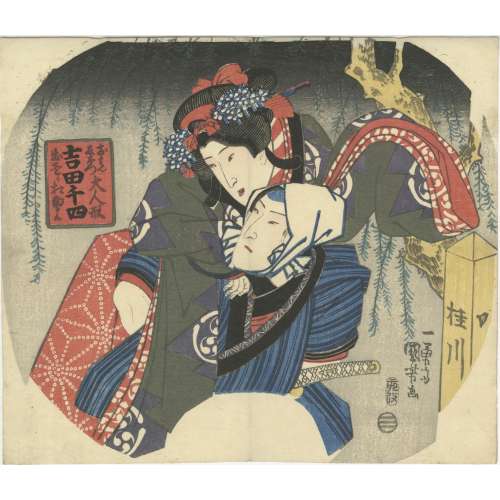Artist: Utagawa Kuniyoshi [
歌川 國芳] (Japanese, 1798
– 1861).
Publisher: Ibaya Senzaburō [伊場屋仙三郎] (Japanese, c. 1815 – 1869).
Date-aratame seal: 1827 (Bunsei 10).
Inscription: Ohan [おはん], Chōemon [長右衛門] | Dainingyō [大人形] | Yoshida Senshi [吉田千四)] | unclear (work in progress).
Sam. L. Leiter describes the play in his
Kabuki Encyclopedia (1979) p. 183, and
Japanese traditional theatre (2014), p. 252 as "Love Suicide of Ohan and Choemon at the Katsura River" (
Katsuragawa Renri no Shigarami) [桂川連理柵], a two-act play by Suga Sensuke [菅専助] (ca. 1728 – 1791) written in 1776 for the puppet theatre jūruri and adopted for Osaka kabuki in 1777.
Yoshida Senshi, a.k.a. Yoshida Bunzaburo III was a Japanese puppeteer of a Yoshida lineage. The line was established by Yoshida Bunzaburō I [吉田文三郎] (Japanese, fl. 1717 – 1760), who was one of the greatest in the history of
Bunraku [人形浄瑠璃] (
ningyō jōruri) and who around 1734 introduced the three-man puppet manipulation system.
A portrait of Yoshida Senshi, who died in 1829, can be found in the Kunisada's triptych at Jordan Schnitzer Museum of Art, ID Number
2016:37.2.).

The design on our fan print looks very much like the one of Toyokuni I at MFA (Houston):
OBJECT NUMBER 2006.378. "Seki Sanjuro as Obiya Choemon and Ichikawa Denzo as Ohan of the Shinonoya from the Kabuki Drama Katsuragawa renri no shigarami (Love Suicide of Ohan and Choemon at the Katsura River)", according to MFA-H published by someone Tsuruya in c. 1810 (though the publisher's seal is Suzuki Ihei [鈴木伊兵衛]
(seal name Suzui [鈴伊]), Marks 01-028 | 502; the censor's seal is gyōji, date 1811-14).

Interestingly enough, the description provided by
Kuniyoshi Project is this "Actors: Onoe Kikugorô III as Shinanoya Ohan (おはん, female) and Ichikawa Ebizô V as Obiya Choemon (長右衛門, male). Play:
Go chumon shusu no Obiya (御注文繻子帯屋). Date: 3
rd month of 1840. Theater: Kawarasaki. Publisher: Iba-ya Sensaburô".
The play
Go chumon shusu no Obiya was indeed staged at Kawarazaki theatre in 1840 (Tenpō 11), 3rd month; Ichikawa Ebizō V was indeed playing Obiya Choemon but Onoe Kikugorō III had the role of Kataoka Kōzaemon, not of Ohan, as can be seen on Kunisada's diptych at MFA (Boston):
ACCESSION NUMBER 11.40671a-b.

Actors Ichikawa Ebizô V as Obiya Chôemon (R) and Onoe Kikugorô III as Kataoka Kôzaemon (L)






 The design on our fan print looks very much like the one of Toyokuni I at MFA (Houston):
The design on our fan print looks very much like the one of Toyokuni I at MFA (Houston):  Interestingly enough, the description provided by
Interestingly enough, the description provided by 

























